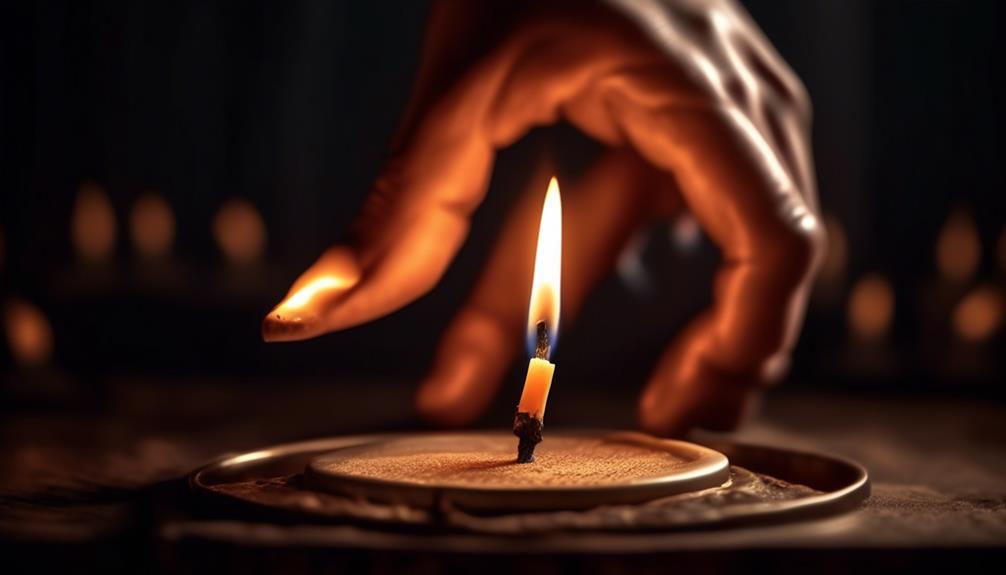Have you ever pondered why blowing out a candle puts out its flame? Allow me to illuminate this subject.
Blowing out a candle works because we use the power of our breath to disrupt the delicate balance of oxygen needed for combustion. You see, when we blow on the flame, we deprive it of the oxygen it requires to keep burning.
As a result, the flame weakens and eventually goes out. It’s a simple yet fascinating phenomenon that allows us to safely extinguish candles and prevent accidents.
So, the next time you find yourself blowing out a candle, remember the science behind it and the role you play in keeping others safe.

Key Takeaways
- Combustion is a chemical reaction that occurs when a substance is ignited and releases heat and light.
- Oxygen is essential for combustion to occur and the flame of a candle constantly consumes oxygen from its surroundings.
- Blowing out a candle disrupts its contact with surrounding oxygen, leading to extinction.
- Blowing out a candle can cause a decrease in oxygen levels and potentially create a safety hazard, so alternative methods like using a candle snuffer or lid should be prioritized.
The Science of Combustion
Understanding the process of combustion involves observing the chemical reaction that occurs when a substance, such as a candle, is ignited and releases heat and light. Combustion is a complex process that involves the interaction between fuel, oxygen, and heat.
When a candle is lit, the heat from the flame melts the wax, which is drawn up the wick by capillary action. As the wax vaporizes, it combines with oxygen from the air and ignites, creating a flame. The flame dynamics of a candle involve the continuous combustion of fuel vapors, which produce heat and light.
Heat transfer occurs through conduction, convection, and radiation, with the flame transferring heat to its surroundings. Understanding flame dynamics and heat transfer is crucial for various applications, such as designing more efficient combustion systems and ensuring safety in fire prevention and control.
Role of Oxygen in Candle Burning
We need oxygen to keep a candle burning. Oxygen is essential for combustion to occur. Here are four reasons why oxygen plays a crucial role in candle burning:

- Oxygen consumption: The flame of a candle constantly consumes oxygen from its surroundings. This process, known as combustion, allows the candle to sustain its burning.
- Flame suppression techniques: Flame suppression techniques, such as blowing out a candle, work by removing or limiting the oxygen supply. When we blow out a candle, we interrupt the flow of oxygen to the flame, extinguishing it.
- Oxygen and heat transfer: The presence of oxygen enables efficient heat transfer within the candle. This allows the wax to melt and vaporize, providing fuel for the flame to continue burning.
- Candle brightness: The amount of oxygen available affects the brightness of the candle flame. Sufficient oxygen results in a bright, steady flame, while limited oxygen can cause a dimmer or flickering flame.
Understanding the role of oxygen in candle burning helps us appreciate the science behind extinguishing a flame and its impact on the candle’s behavior.
Understanding the Flame
The flame of a candle, as mentioned earlier, relies on a continuous supply of oxygen to sustain its burning. Understanding the flame dynamics and heat transfer involved can help shed light on why blowing out a candle works.
When a candle burns, the heat from the flame vaporizes the wax, causing it to rise as a gas. This rising gas creates convection currents, which draw fresh oxygen from the surrounding air towards the flame. The heat transfer between the flame and the wax sustains the continuous combustion process.
When we blow on the flame, we disrupt the convection currents and introduce a sudden burst of air, which causes the flame to flicker and extinguish. By doing so, we remove the oxygen supply needed for the flame to burn, effectively putting out the candle.

Introduction to Blowing Out
When it comes to blowing out a candle, there are a few key points to consider.
Firstly, blowing out a candle works due to the mechanism of oxygen depletion. By blowing on the flame, we reduce the amount of oxygen available, which eventually leads to the flame extinguishing.
However, it’s important to take safety precautions when blowing out a candle to avoid any accidents or injuries.
Oxygen Depletion Mechanism
Blowing out a candle works by rapidly extinguishing the flame through the depletion of oxygen. When we blow on a candle, four key oxygen depletion effects occur, which collectively lead to the extinguishing of the flame:

- Increased airflow: Our breath creates a stream of air that disrupts the stable environment around the flame, causing it to flicker and weaken.
- Oxygen displacement: As we blow on the candle, the carbon dioxide in our breath replaces the oxygen surrounding the flame, reducing the oxygen concentration and hindering combustion.
- Cooling effect: The fast-moving air from our breath cools down the flame, making it more difficult for it to sustain its heat and continue burning.
- Turbulence: The turbulence created by our breath disturbs the flame’s shape and size, making it harder for the flame to maintain its structure and stay lit.
Extinguishing the Flame
To extinguish the flame, we gently blow a small amount of air onto the candle. When we blow out a candle, we disrupt the delicate balance between the flame and its oxygen supply. The flame requires oxygen to sustain combustion, and by blowing on it, we decrease the amount of oxygen reaching the flame.
As we blow, the movement of air disturbs the flame, causing it to flicker and dance. This disturbance disrupts the flame’s contact with the surrounding oxygen, ultimately leading to its extinction. The behavior of the flame changes as we blow on it, becoming weaker and smaller until it eventually goes out.
Safety Precautions Needed
Before we blow out a candle, it’s important to take necessary safety precautions. Here are four key safety measures to consider:
- Ensure proper ventilation: Before extinguishing a candle, make sure the room has adequate oxygen levels. A poorly ventilated space can lead to a buildup of carbon dioxide, which can be dangerous.
- Keep flammable materials away: Remove any flammable objects or materials from the vicinity of the candle. This includes curtains, paper, and other combustible items that may pose fire hazards.
- Use a candle snuffer or lid: Instead of blowing out a candle directly, use a candle snuffer or place a lid over it to extinguish the flame. This helps prevent hot wax from splattering and reduces the risk of accidental fires.
- Never leave a burning candle unattended: Always stay vigilant when candles are lit. Ensure that someone is present to monitor the candle and promptly extinguish it if necessary.
The Extinguishing Process
When we extinguish a candle, the rapid depletion of oxygen within the flame causes its combustion to cease. This is because fire requires oxygen to sustain itself. As we blow out the candle, we disrupt the oxygen concentration around the flame, reducing the amount available for combustion. Without sufficient oxygen, the flame can’t continue to burn.

Additionally, the wax of the candle acts as a fuel source, but it needs oxygen to ignite and sustain the flame. By blowing out the candle, we remove the oxygen necessary for the combustion process. This extinguishing process is also aided by the flame’s resistance to external factors, such as wind or air movement, which helps maintain its shape and intensity.
Understanding the mechanics behind candle extinguishing allows us to explore the factors influencing this process.
Factors Influencing Candle Extinguishing
One factor that influences candle extinguishing is the distance between the flame and the person blowing it out. Here are four important factors that affect the process:
- Oxygen levels: Blowing on a candle reduces the surrounding oxygen concentration, which interferes with the combustion process. With less oxygen available, the flame struggles to sustain itself and eventually goes out.
- Thermal conductivity: When we blow on a candle, the air we exhale cools down the surrounding environment. This decrease in temperature affects the candle’s thermal conductivity, making it harder for heat to transfer from the wick to the wax. As a result, the fuel supply is disrupted, causing the flame to extinguish.
- Distance from the flame: The closer we’re to the candle flame, the more air we can direct towards it. This increases the force of the airflow, making it easier to blow out the candle.
- Technique: The way we blow on the candle also plays a role. A focused and steady stream of air is more effective in extinguishing the flame than a scattered or inconsistent breath.
Understanding these factors helps us better control the candle extinguishing process.

Now, let’s explore the impact of air movement on the flame.
Impact of Air Movement on Flame
When it comes to extinguishing a flame, the impact of air movement plays a crucial role. By blowing on a candle, we disrupt the flow of oxygen, causing the flame to dwindle and eventually go out.
This is because fire requires oxygen to sustain combustion, and when we blow on it, we deprive it of this essential element, leading to its extinction.
Extinguishing the Flame
As we blow on a candle, the movement of air extinguishes the flame. Understanding how air movement affects the flame behavior is crucial in explaining why blowing out a candle works.
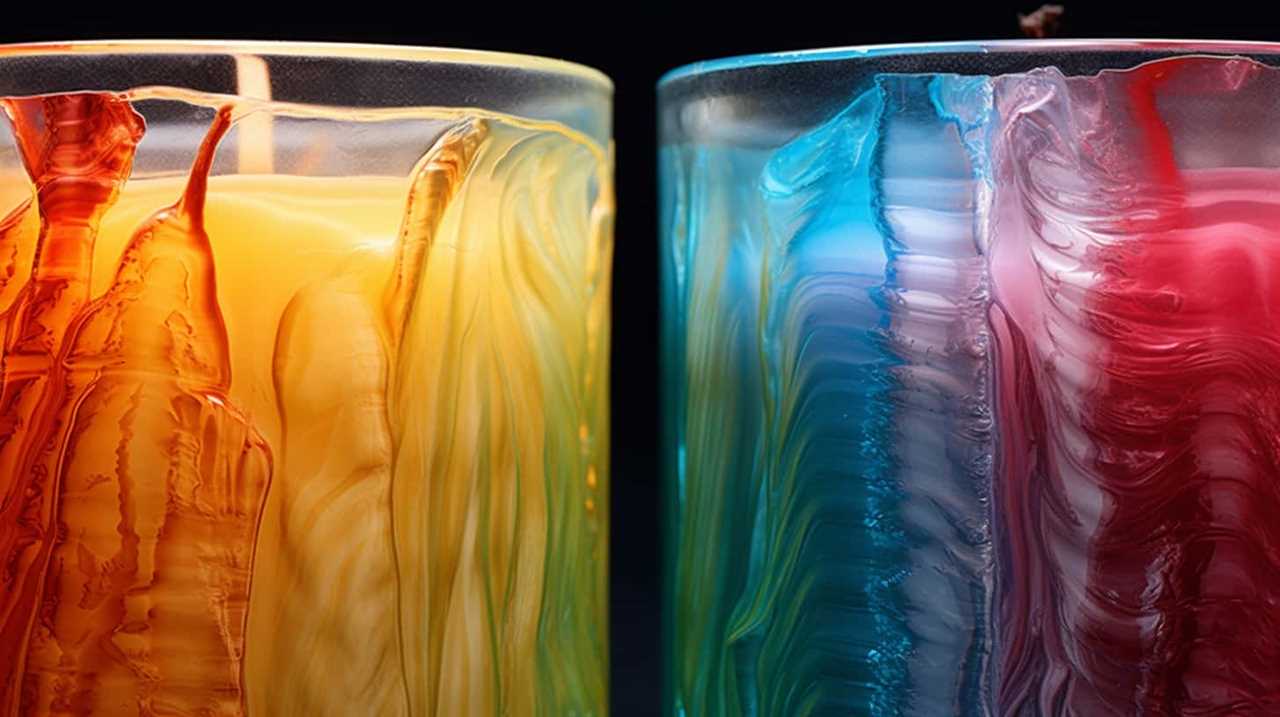
Here are four key points to consider:
- Oxygen supply: When we blow on a candle, we disrupt the flow of oxygen to the flame. Oxygen is vital for combustion, and without it, the flame can’t sustain itself.
- Air pressure: Blowing on a candle creates a higher pressure zone around the flame. This higher pressure pushes the flame away from its fuel source, causing it to flicker and eventually go out.
- Heat dispersal: The movement of air carries away the heat produced by the flame. As the flame loses heat, it becomes increasingly difficult for it to maintain the necessary energy for combustion.
- Disruption of fuel vapor: Blowing on a candle disturbs the volatile fuel vapor that sustains the flame. This disruption reduces the concentration of flammable fuel, making it harder for the flame to continue burning.
Understanding these factors helps us transition into the subsequent section, where we’ll explore how oxygen deprivation causes the extinction of a flame.
Oxygen Deprivation Causing Extinction
To understand how oxygen deprivation causes the extinction of a flame, we can observe the impact of air movement on the flame.
When air is blown onto a flame, it disrupts the balance of oxygen levels around it. Oxygen is essential for the combustion process, as it reacts with the fuel to sustain the flame.

By blowing air onto the flame, we increase the air movement and reduce the concentration of oxygen near the fuel source. This decrease in oxygen levels prevents the combustion process from continuing, ultimately leading to the extinction of the flame.
Understanding this phenomenon is crucial for fire prevention, as controlling air movement can help us prevent and extinguish fires effectively.
Now, let’s explore the effectiveness of different blowing techniques in extinguishing flames.
Effectiveness of Different Blowing Techniques
In terms of blowing out a candle, various blowing techniques can differ in their effectiveness. To serve others better, it’s important to understand the factors that can impact the effectiveness of breath control. Here are four key considerations:

- Force of breath: The strength of the exhaled air can determine how effectively it extinguishes the flame. A stronger and focused breath is more likely to put out the candle.
- Distance: The proximity of the blower to the candle can affect the success rate. Being too far away may disperse the air before it reaches the flame, while being too close may cause the flame to reignite.
- Angle: The angle at which the breath is directed towards the candle can also influence its effectiveness. Blowing directly at the flame from above or slightly from the side is often more successful.
- Candle size: The size of the candle can impact the effectiveness of blowing techniques. Larger candles may require more forceful and focused breaths to extinguish.
Understanding these factors can help us develop better breath control and ensure successful candle extinguishing.
Now, let’s explore the alternative method of snuffing a candle.
Blowing Out Vs. Snuffing
When it comes to extinguishing a candle, there are two main methods: blowing out and snuffing.
Blowing out a candle is a common technique that involves using a gust of air to extinguish the flame. It is a straightforward method that most people are familiar with. By blowing on the flame, the oxygen supply is disrupted, causing the flame to go out. This method is quick and easy, but it can also be a bit messy, as it may cause wax splatters or create smoke.
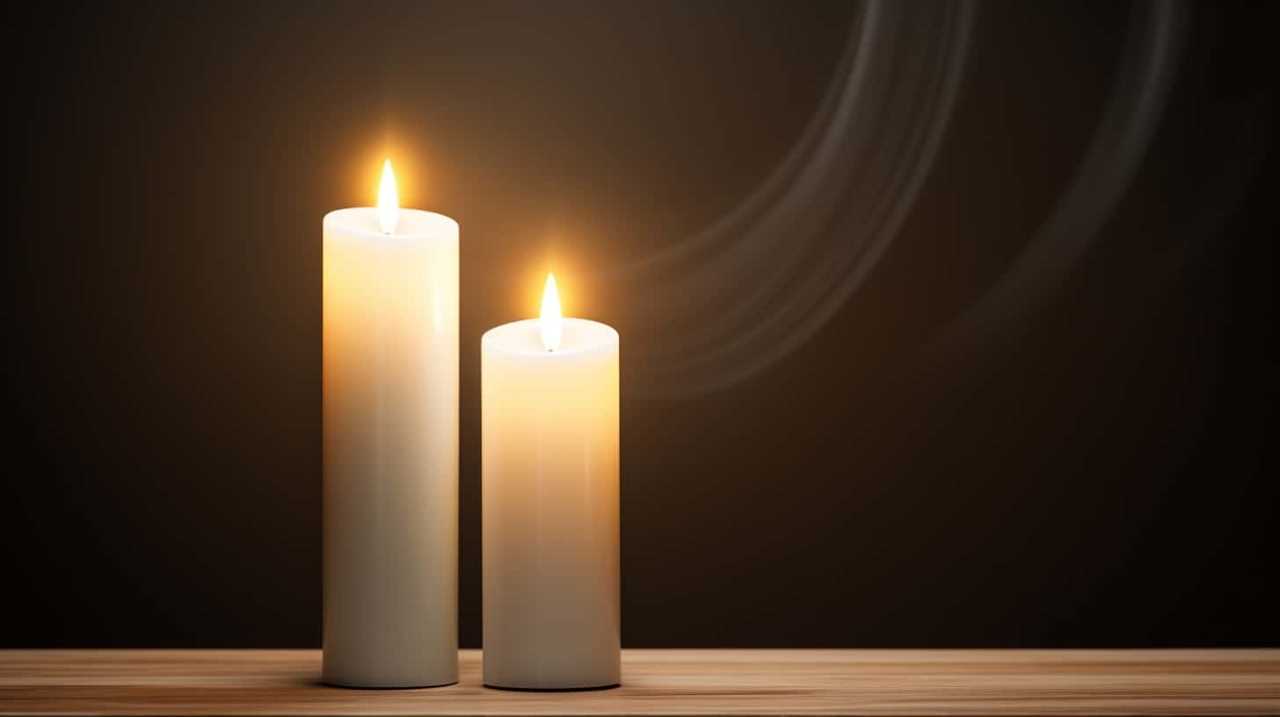
On the other hand, snuffing involves using a snuffer, a small tool specifically designed for extinguishing candles. A snuffer typically consists of a bell-shaped or cone-shaped cover attached to a long handle. To snuff a candle, you simply place the snuffer over the flame, cutting off the oxygen supply and causing the flame to go out. This method is considered more controlled and safer than blowing out a candle. It helps avoid any splattering or smoke that may occur when blowing out the flame.
Both methods are effective in putting out a flame, but they differ in terms of the mechanism behind them and the safety considerations involved. It ultimately comes down to personal preference and the specific situation. Some people may prefer the simplicity and ease of blowing out a candle, while others may prefer the controlled and safer approach of snuffing.
Effectiveness of Blowing
Although snuffing a candle is a common alternative, blowing it out is generally more effective. Here’s why:
- Oxygen depletion: When we blow out a candle, we use our breath to disrupt the oxygen supply to the flame. Without oxygen, the combustion process can’t continue, and the flame extinguishes.
- Force of air: Blowing out a candle produces a forceful gust of air that can quickly and efficiently extinguish the flame. This method is especially effective for larger candles or candles with a strong flame.
- Precision: By controlling the direction and intensity of our breath, we can target the flame directly, ensuring a swift and complete extinguishment.
- Safety: Blowing out a candle allows us to maintain a safe distance from the flame, reducing the risk of burns or accidental fires.
While alternative methods like snuffing may work in certain situations, blowing out a candle remains the most effective and widely-used technique.

Mechanism Behind Snuffing
To understand the mechanism behind snuffing a candle, we must compare it to the process of blowing it out. When we blow out a candle, we extinguish the flame by removing the oxygen it needs to sustain itself. As we blow, we create a gust of air that disrupts the flame’s contact with the surrounding oxygen, leading to its extinguishment.
On the other hand, snuffing a candle involves using a device called a snuffer to cover the flame, cutting off its access to oxygen. This method also results in the flame being deprived of the oxygen it needs to continue burning. Understanding the differences in oxygen consumption and flame behavior between blowing and snuffing can help us explore the most effective ways to extinguish candles safely.
Let’s now delve into the safety considerations when blowing out a candle.
Safety Considerations When Blowing
Let’s now explore the safety considerations when blowing out a candle compared to snuffing, focusing on the differences in oxygen consumption and flame behavior.
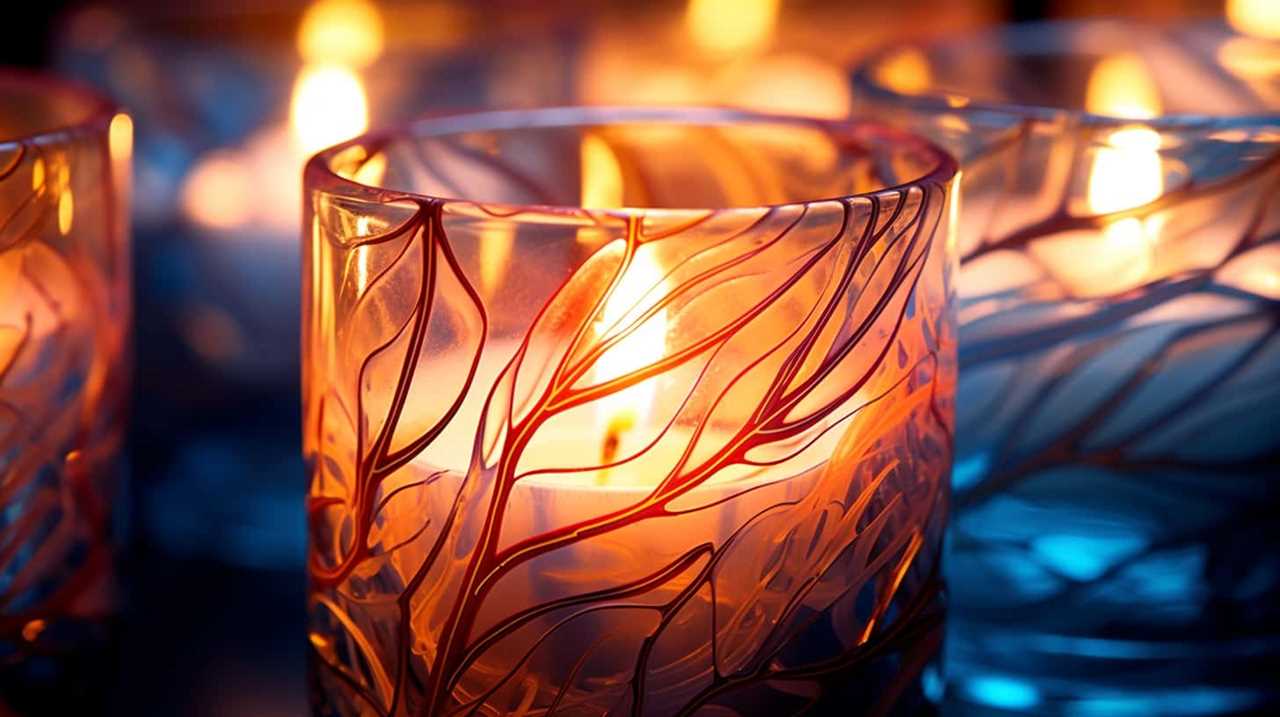
When it comes to extinguishing a candle, whether by blowing it out or snuffing it, there are some important safety factors to consider. Here are four key points to keep in mind:
- Oxygen depletion:
Blowing out a candle involves the use of our breath, which can cause a significant amount of oxygen to be consumed in the process. This can lead to a decrease in the oxygen levels in the immediate vicinity of the candle, potentially creating a safety hazard. - Air movement:
When blowing out a candle, the force of the air movement can cause the flame to flicker, potentially spreading hot wax or sparks. This can increase the risk of accidental fires or burns. - Flame behavior:
Blowing out a candle can sometimes result in the flame spluttering or re-igniting momentarily. This can be dangerous if it catches nearby flammable materials. - Snuffing alternatives:
Snuffing a candle using a snuffer or a candle extinguisher can be a safer alternative, as it doesn’t involve the same level of oxygen consumption or air movement. This can help minimize the risk of accidents or fire hazards.
The Role of Carbon Dioxide
One of the primary reasons blowing out a candle is effective is because we produce carbon dioxide when we exhale. Carbon dioxide plays a crucial role in extinguishing a candle flame.
When we blow on the flame, we introduce a stream of carbon dioxide-rich air onto it. This increase in carbon dioxide concentration disrupts the delicate balance of the flame dynamics. The flame requires oxygen to sustain itself, but when carbon dioxide is present in higher amounts, it displaces oxygen and deprives the flame of its necessary fuel.
As a result, the flame is unable to sustain itself and is extinguished. So, by blowing on a candle, we’re essentially suffocating the flame with the carbon dioxide in our breath, effectively putting it out.
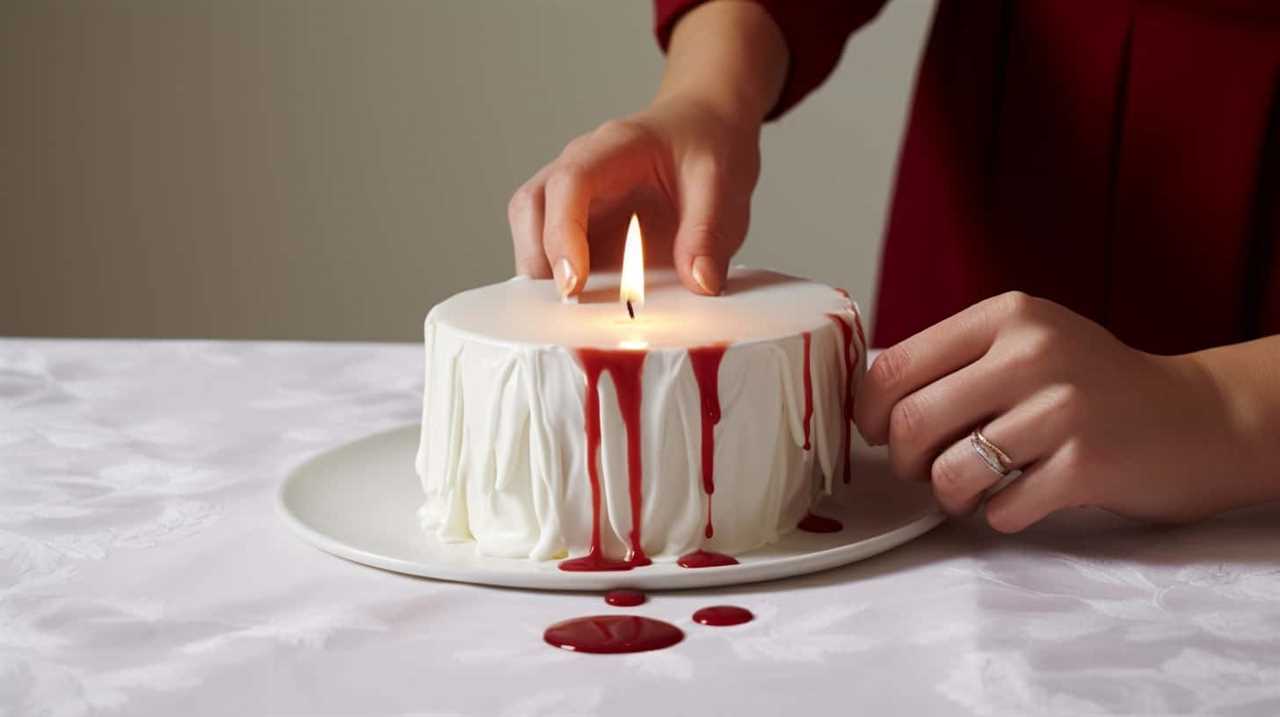
Extinguishing With Other Gases
Let’s explore the use of different gases for extinguishing fires.
While carbon dioxide is commonly used, there are also alternative gas extinguishers such as halon, argon, and nitrogen.
It’s important to consider the effectiveness of these alternatives and any potential safety concerns associated with their use.
Different Gas Extinguishers
How can we extinguish a candle using different gases?
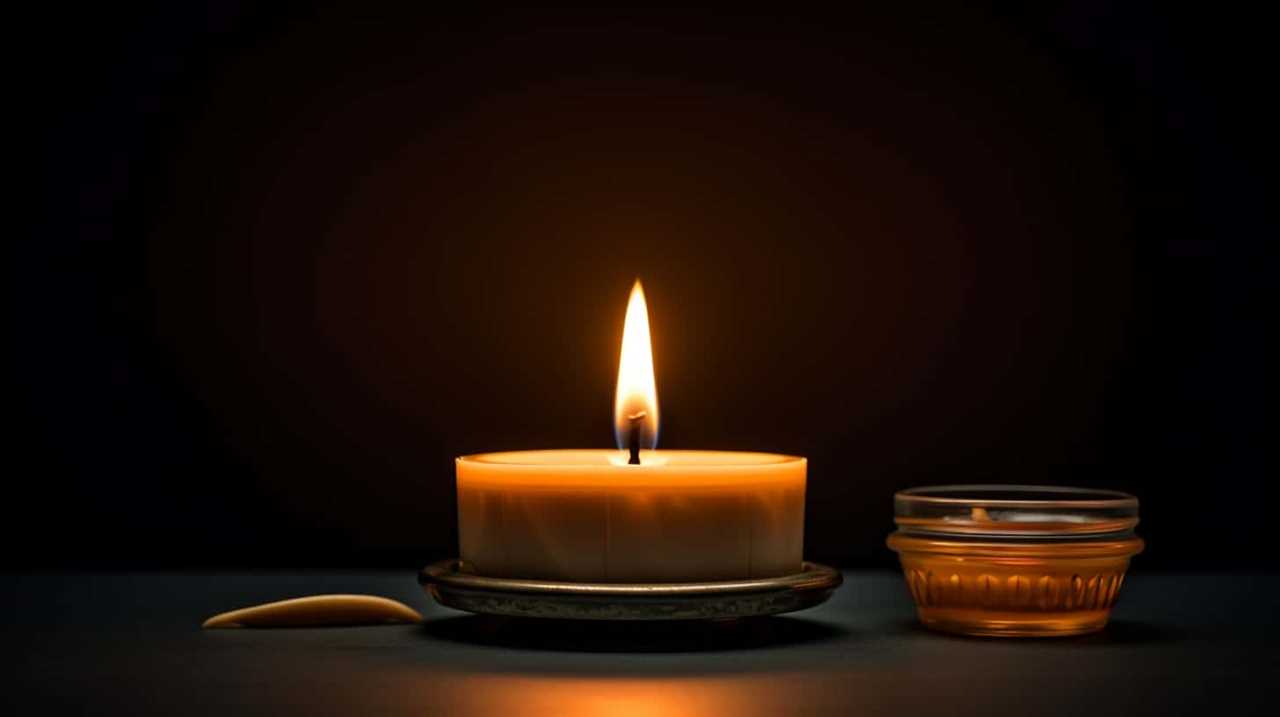
There are several gases that can be used to put out a candle flame. Here are four different gas extinguishers and how they work:
- Carbon Dioxide (CO2): This gas deprives the flame of oxygen by displacing it, effectively smothering the fire. It reduces the oxygen levels around the flame, making it impossible for the fire to sustain itself.
- Nitrogen (N2): Nitrogen is an inert gas that doesn’t support combustion. By flooding the area around the flame with nitrogen, it lowers the flame temperature and prevents it from spreading.
- Halon: Halon gases disrupt the chemical reactions that occur during combustion. They interfere with the flame’s ability to sustain itself, effectively extinguishing the fire.
- Argon (Ar): Similar to nitrogen, argon is an inert gas that displaces oxygen. It suffocates the flame by reducing the oxygen levels in the surrounding area.
These alternative gases offer different methods of extinguishing a candle flame, each with their own effectiveness and applications.
Effectiveness of Alternative Gases
To further explore the topic, let’s delve into the effectiveness of using alternative gases to extinguish candles.
When it comes to alternative gases, nitrogen is often considered an effective option. Nitrogen is an inert gas that doesn’t support combustion, making it ideal for extinguishing fires. Compared to other gases like carbon dioxide or argon, nitrogen has a higher effectiveness in extinguishing candles.

This is because nitrogen displaces the oxygen in the air, reducing the oxygen concentration and suffocating the flame. Furthermore, nitrogen is non-toxic and non-reactive, making it a safe choice for fire suppression.
However, it’s important to note that the effectiveness of alternative gases may vary depending on factors such as the size of the fire and the environment.
Safety Concerns With Alternatives?
There are inherent safety concerns associated with using alternative gases to extinguish candles. While these methods may seem convenient or innovative, it’s important to prioritize safety precautions to prevent accidents. Here are four reasons why alternative methods can pose risks:
- Increased fire hazard: Some alternative gases, such as aerosol sprays or lighter fluids, are highly flammable and can increase the risk of fire if used near an open flame.
- Toxic fumes: Certain gases, like carbon dioxide or helium, can displace oxygen in the air and lead to suffocation or respiratory issues.
- Lack of control: Using alternative gases may result in a lack of control over the extinguishing process, making it difficult to ensure the flame is completely extinguished.
- Potential damage to surroundings: Some gases, like foam or powder extinguishers, can cause damage to furniture, fabrics, or other materials in the vicinity of the candle.
Considering these safety concerns, it’s essential to prioritize using traditional and safe methods, such as blowing out a candle or using a fire extinguisher specifically designed for fires involving candles.

Candle Extinguishing Safety Tips
When extinguishing a candle, we should always be mindful of the safety precautions involved. Proper candle extinguishing techniques are essential in preventing candle accidents and ensuring the safety of ourselves and our surroundings.
To extinguish a candle safely, it’s recommended to use a candle snuffer or gently blow it out. Avoid using your fingers or any flammable material to put out the flame. Additionally, make sure there are no flammable objects near the candle, and always place it on a stable surface. Remember to keep candles away from drafts and out of reach of children and pets.
By following these safety tips, we can enjoy the warm glow of candles without compromising our safety.
Now, let’s explore how blowing out candles in different environments can affect the outcome.

Blowing Out Candles in Different Environments
Blowing out candles in various settings can yield different results. Here are four factors that can affect the process:
- Oxygen levels: In environments with high oxygen levels, such as outdoors or well-ventilated rooms, blowing out a candle becomes easier. The increased oxygen supply helps the flame extinguish quickly.
- Candle placement: The position of the candle can also influence the ease of extinguishing. When the candle is placed in a drafty area, such as near an open window or a fan, the moving air can make it more challenging to blow out the flame.
- Candle size: Larger candles tend to have thicker wicks, which require more force to extinguish. Smaller candles, on the other hand, have thinner wicks and are easier to blow out.
- Wick quality: The quality of the candle wick can also affect the ease of blowing out. A well-made wick will burn evenly and be easier to extinguish.
Understanding these factors can help us adapt our blowing technique in different environments. Now, let’s explore the historical significance of blowing out candles.
Historical Significance of Blowing Out
Throughout history, humans have used the act of extinguishing candles as a symbolic gesture to mark the end of events or ceremonies. The historical origins of blowing out candles can be traced back to ancient civilizations such as the Greeks and Romans. In these cultures, candles were often used in religious rituals and ceremonies. Blowing out the candle at the end of these rituals signified the completion of the spiritual connection or the end of the ceremony.
Over time, this practice spread to other cultures and became a common tradition. The cultural significance of blowing out candles has evolved to represent the extinguishing of negativity, the conclusion of a celebration, or the transition from one phase to another. Today, blowing out candles remains a symbolic act that carries historical and cultural meaning.

Surprising Facts About Candle Extinguishing
One surprising fact about candle extinguishing is its effectiveness in depriving the flame of oxygen. When we blow out a candle, we’re using a technique called candle snuffing to cut off the oxygen supply to the flame.
Here are some surprising facts about candle extinguishing:
- Blowing out a candle creates a sudden rush of air that disrupts the balance of oxygen fueling the flame, causing it to go out.
- The force of the air from our breath can vary, and the technique used to blow out a candle can affect how easily it extinguishes.
- Candle snuffing, which involves using a tool specifically designed to extinguish candles, can be more effective than blowing with our breath alone.
- Blowing out a candle not only extinguishes the flame but also creates a sense of calm and tranquility, making it a popular ritual for relaxation and mindfulness.
Understanding the surprising facts about candle extinguishing can enhance our experience and enjoyment when using candles in our daily lives.
Frequently Asked Questions
Can Blowing Out a Candle Cause Any Harm or Damage?
Blowing out a candle can potentially cause harm or damage if proper safety precautions are not taken. It is important to be mindful of potential health risks, such as inhaling smoke or accidentally starting a fire.

Is There a Specific Way to Blow Out a Candle to Ensure It Is Fully Extinguished?
To ensure a candle is fully extinguished, there are different techniques for blowing it out. Blowing out a candle does affect its burn time, as it stops the wax from melting and the wick from burning.
Can Blowing Out a Candle Produce Any Hazardous Gases or Substances?
Blowing out a candle can lead to potential health risks from prolonged exposure to candle smoke. Additionally, it releases particulate matter into the air, contributing to environmental impact.
Are There Any Alternative Methods to Extinguishing a Candle Other Than Blowing It Out?
Looking for alternative methods to blow out a candle? Candle snuffers offer a safe and elegant way to extinguish the flame. Water immersion, on the other hand, may not be as effective as blowing out the candle.
Does the Size or Type of Candle Affect How Easily It Can Be Blown Out?
The size or type of candle can affect how easily it can be blown out. Wind speed has an effect on blowing out candles, and the composition of the candle wax can also impact the ease of extinguishing.
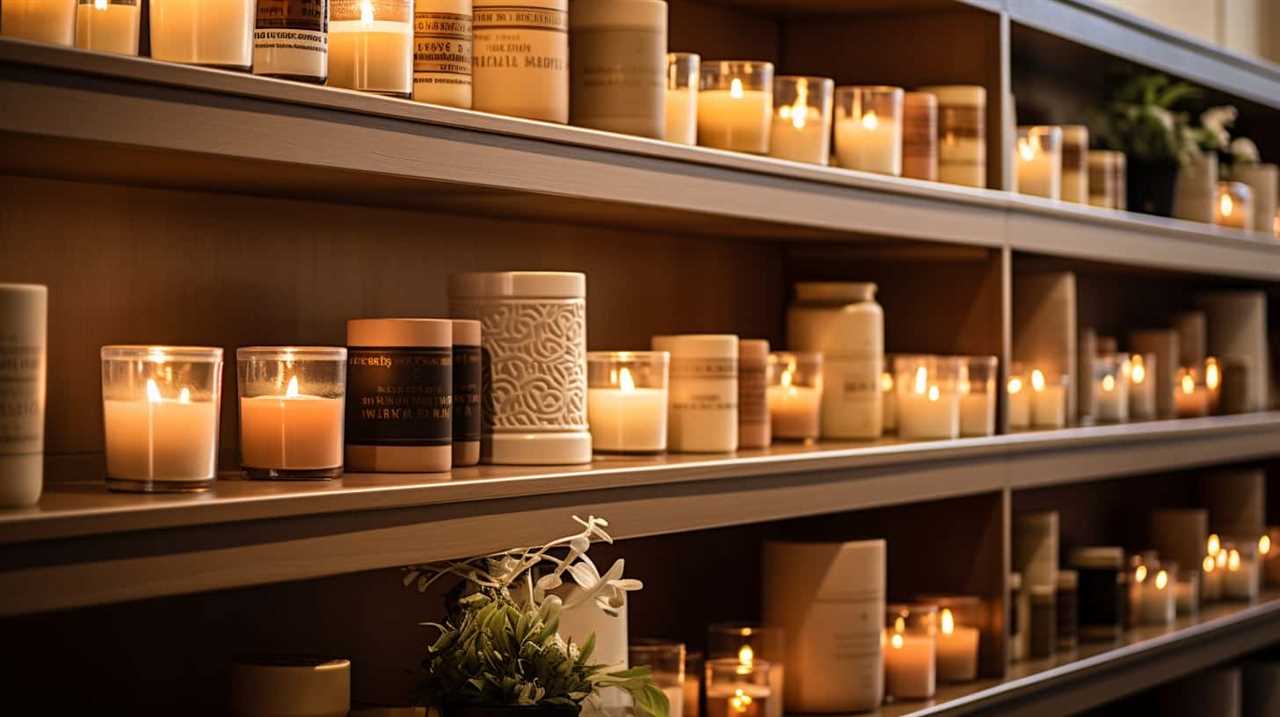
Conclusion
So, why does blowing out a candle work?
It all comes down to the fundamental science of combustion. By depriving the flame of oxygen, we disrupt the chemical reaction that sustains it, causing the flame to extinguish.
Blowing out a candle may seem like a simple act, but it holds deeper significance. It symbolizes our ability to control and manipulate the elements around us, reminding us of the power we possess to shape our environment.











